Most notably, alfalfa forage growers near Goldendale, Washington, had reported field failures with the formulated pre-mix insecticide Cobalt in 2018.
Cobalt is an insecticide marketed by Corteva Agriscience and is a mixture of the organophosphate insecticide chlorpyrifos (aka Lorsban Advanced) and the synthetic pyrethroid lambda-cyhalothrin (aka Warrior). Field failures were not unique to a single grower. In response, we submitted a small grant request to the National Alfalfa and Forage Alliance checkoff program for research funding. This request for funding was, in turn, leveraged with another request for funding from the Washington State Commission on Pesticide Registration.
Field efficacy trials
In late spring, we completed two insecticide efficacy field trials and a series of controlled laboratory bioassays. One field trial was completed near Goldendale, Washington, and the other was completed near Prosser, Washington. Candidate chemistries included in both field trials are detailed in Table 1.
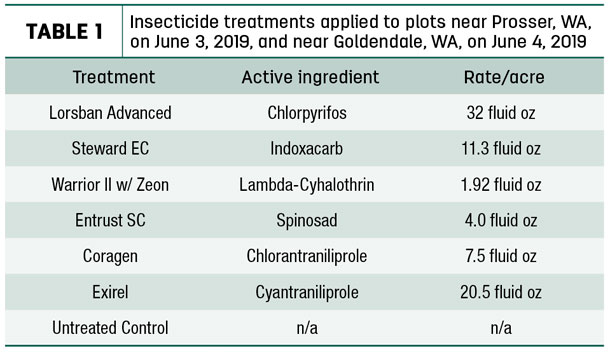
Each insecticide treatment was applied to four replicates that were 12 feet by 20 feet, for a total of 240 square feet per replicate. Insecticides were applied by CO2-powered backpack sprayer in dilution at approximately 20 gallons per acre. The plots near Prosser were sampled by sweep net on June 5, June 7 and June 10, specifically one, three and six days after treatment. The plots near Goldendale were sampled on June 5, June 7 and June 20, specifically one, three and 16 days after treatment. Each sample consisted of five 180-degree sweeps. These data are displayed in Figures 1 and 2.
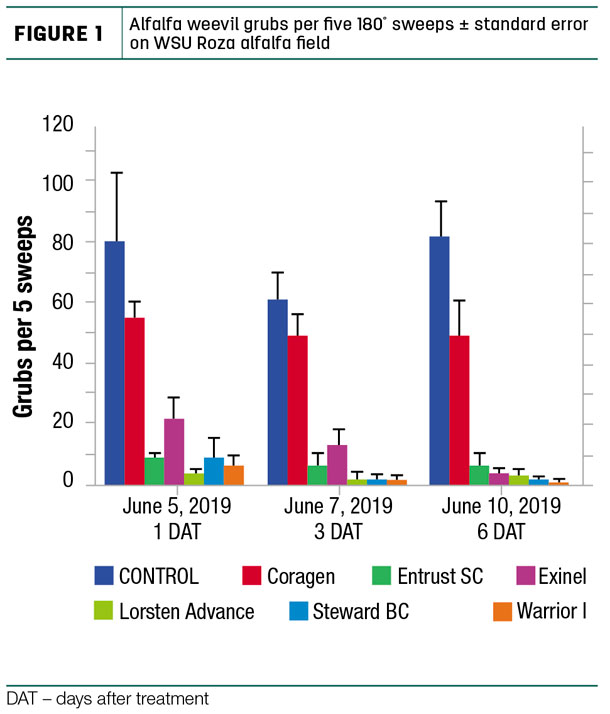
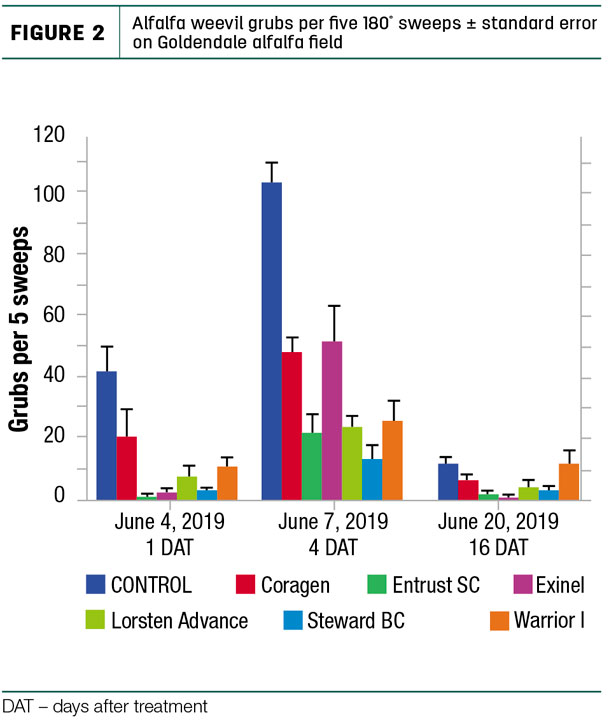
The alfalfa plot on the Roza near Prosser was in a field used for small-plot insecticide efficacy work. It is surrounded by over 80 acres of alfalfa forage that is never sprayed with insecticides. We consider the Lygus from this site to be an insecticide-susceptible population because of this lack of spraying history. The Goldendale site had been treated at least once and sometimes twice with Cobalt in each of the past several years. We did not include Cobalt as a treatment in the trial. Rather, we included Cobalt’s two active ingredients, chlorpyrifos (in Lorsban Advanced) and lambda-cyhalothrin (in Warrior II with Zeon).
From these data, we calculated percent control provided by each insecticide compared to the non-treated control at three days after treatment at the Roza site and four days after treatment at the Goldendale site (Table 2).
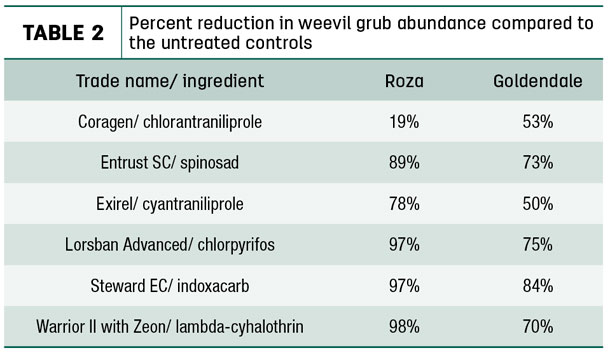
Our results were close to what we predicted. The weevil population from Goldendale with a history of exposure to insecticides appears to be more tolerant to insecticides than our susceptible population from the Roza site.
Coragen is an insecticide that targets mainly caterpillars. Hence, we saw relatively low mortality in weevils at both sites. Entrust targets caterpillars, thrips and vinegar flies. Entrust, which is organically certified by the USDA and Washington State Department of Agriculture, provided acceptable control of weevils and could be used in rotation with other insecticides. Exirel, which is not registered for use on alfalfa, controls a wide range of insect pests, including weevils, on crops for which its use is registered.
Lorsban Advanced has been a mainstay insecticide for weevil control for decades. On the Roza, Lorsban Advanced nearly eradicated the weevil population. In Goldendale, control was only 75%. Steward is a recommended insecticide. It was the superior insecticide in these trials, most notably in Goldendale. The low level of control provided by Warrior II with Zeon at the Goldendale site is of concern, giving us reason to believe tolerance is becoming a problem with the weevil populations in Goldendale. This is reinforced in our lab bioassays, which will be described below.
Laboratory bioassays
To quantify the dose response of alfalfa weevil populations in Washington state, we collected weevil larvae at six locations and transported them back to the Environmental and Agricultural Entomology Laboratory at Washington State University – Prosser. These weevils were then subjected to dose response bioassay via our Potter precision spray tower. Larvae populations were collected from sites including our Roza alfalfa field described above, three alfalfa forage fields in Goldendale and two alfalfa forage fields near Touchet. The four insecticides tested included the registered products Warrior (lambda-cyhalothrin), Lorsban Advanced (chlorpyrifos), Steward (indoxacarb), and the experimental, unregistered* insecticide Exirel (cyantraniliprole). (*Exirel is registered on a variety of other field and greenhouse crops but is not registered for use on alfalfa, therefore its inclusion in these studies is experimental and for informational purposes only.)
Serial dilutions were completed for each insecticide, with the maximum field rate in a dilution equivalent to 20 gallons per acre. Subsequent dilutions were made at 75%, 50%, 25%, 10%, 5% and 0% of the maximum field rate, again diluted in the equivalent of 20 gallons of water per acre. Each treatment was applied to four replicates of five weevil grubs in a Petri dish with a filter paper bottom in 2 milliliters of solution in our Potter precision spray tower. The weevil larvae were evaluated at 24 and 48 hours after treatment for mortality and survivorship. Our data evaluations were completed on the weevil mortality after 48 hours of exposure. Weevil larvae were considered dead when they failed to respond to being touched with a fine camel-hair brush.
There was a definite trend with Warrior (lambda-cyhalothrin) in that the weevil larvae from Goldendale appeared to be more tolerant to exposure to Warrior than the other three populations tested (Figure 3).
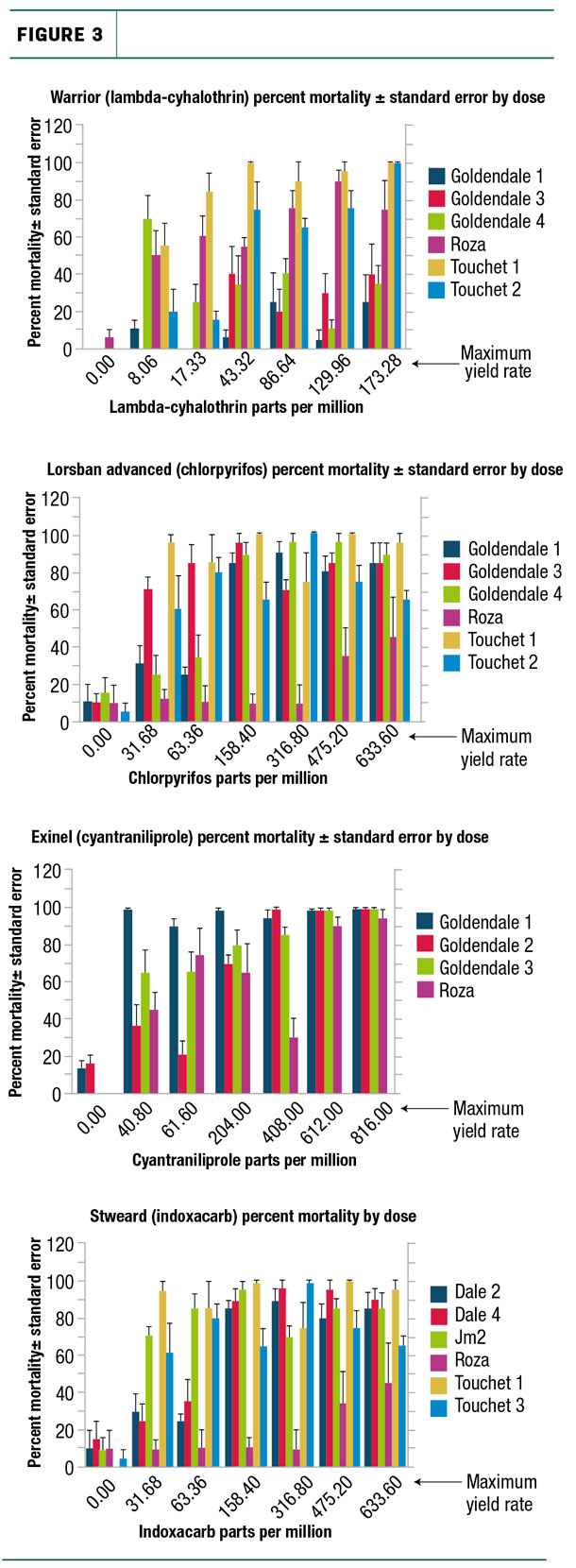
At the maximum field rate equivalent, less than 50% of the weevils were killed. Mortality among the populations collected at the Roza field was 80%, and mortality was 100% from those collected at both Touchet fields. No such trend was in evidence with Lorsban Advanced (chlorpyrifos). What stands out is the response exhibited by the Roza population. The Roza is in proximity to wine grape vineyards and tree fruit orchards; these crops could be receiving delayed dormant season applications of Lorsban Advanced. A similar response was exhibited by the Roza weevil population compared to all the other populations in their response to exposure to Steward.
At present, we have no solid explanation for why the Roza population has greater tolerance to both Lorsban Advanced and Steward compared to all the other populations. We were unable to collect enough weevil larvae from the fields in Touchet to complete bioassays on the weevil populations to the non-registered, experimental insecticide Exirel. However, all the weevil populations from Goldendale and the Roza weevil population appear to be susceptible to the insecticide Exirel. ![]()
Peter Forrence is a scientific assistant with the department of entomology, Irrigated Agriculture Research and Extension Center, Washington State University.
Doug Walsh is a professor with the department of entomology, rrigated Agriculture Research and Extension Center, Washington State University. Email Doug Walsh.









